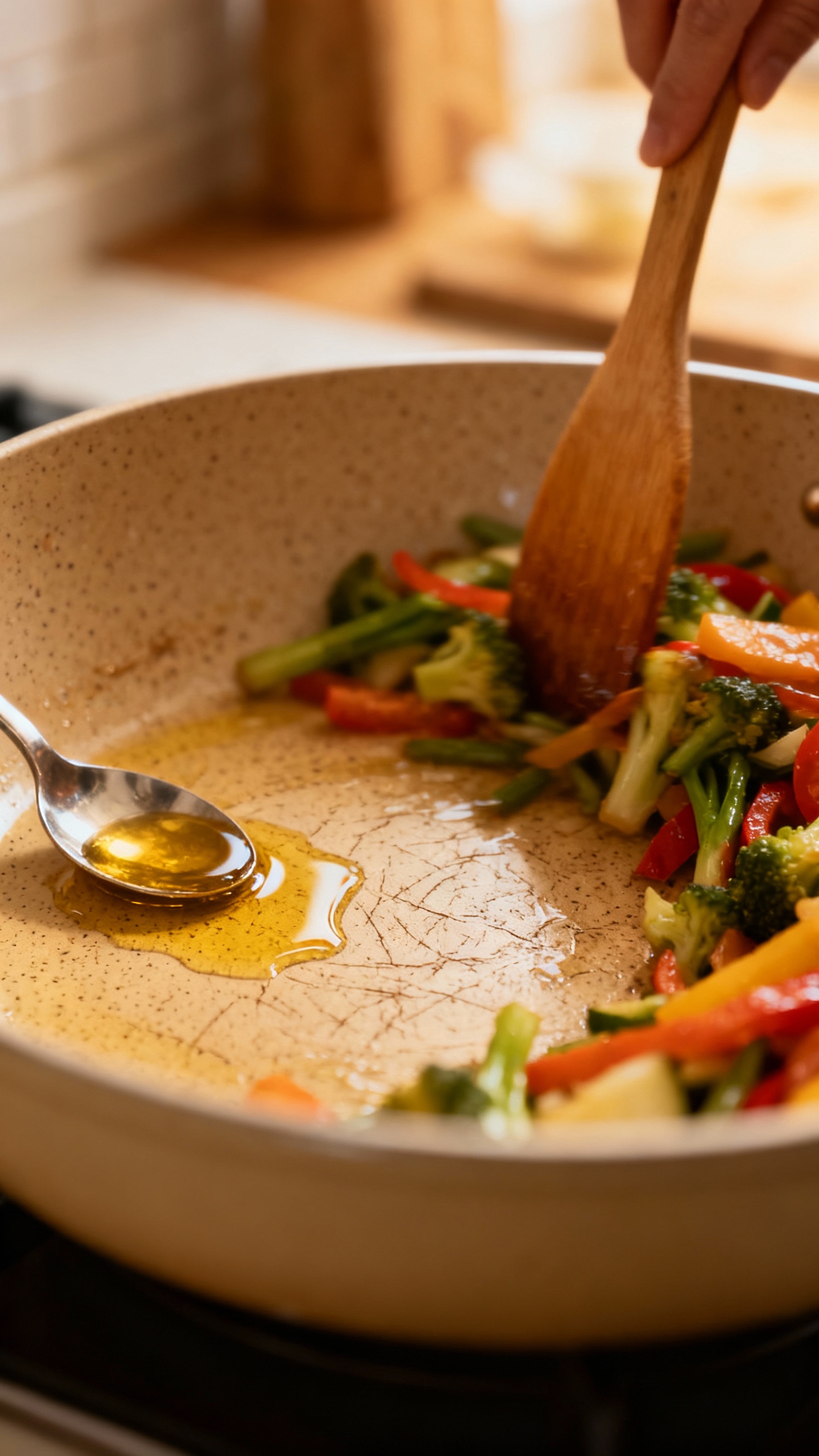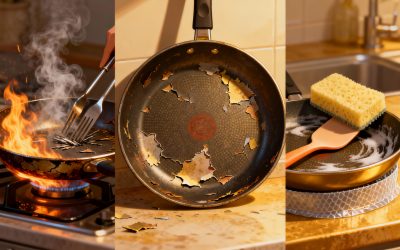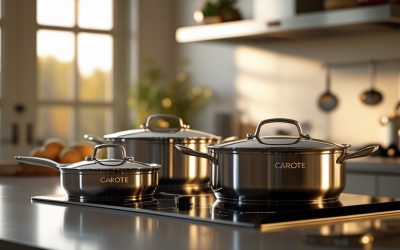Nonstick pans promise breakfast glory: eggs that slip-slide, pancakes that flip like Olympic gymnasts, and cleanup that takes 10 seconds. But which nonstick is the real MVP—ceramic or Teflon? You’ve heard rumors, seen the marketing, maybe scorched a few omelets.
Let’s cut through the hype and figure out which pan actually belongs on your stove.
What “Ceramic” And “Teflon” Actually Mean

Most of us say “ceramic” and “Teflon” like they’re opposites from different planets. They aren’t.
- Teflon = PTFE coating (polytetrafluoroethylene). It’s super slick, time-tested, and used on nonstick pans for decades.
- Ceramic = sol-gel coating made from silica.It’s not a solid chunk of pottery—it’s a glass-like layer sprayed on metal.
- Base materials under both: usually aluminum or hard-anodized aluminum. That affects heat distribution more than the coating does.
Quick chemistry snapshot (no test later)
- PTFE (Teflon) melts and decomposes at high temps, which matters if you cook hot and fast.
- Ceramic coatings harden into a glassy surface that’s smooth at first, then gets micro-scratches and roughens faster over time.
Nonstick Performance: Who’s Slicker?
Short answer: Teflon wins for slipperiness. Eggs glide like they’re on roller skates.
Ceramic starts strong but loses slickness faster.
- Teflon/PTFE: ultra-low friction right out of the box and stays nonstick longer if you treat it nicely.
- Ceramic: feels great the first few weeks. Then you notice you need more oil. Then a little more.Then… hello, scrambled stick-fest.
Real-world test vibe
Imagine cooking scrambled eggs:
- Week 1: both pans are magic.
- Month 2: Teflon still slides. Ceramic needs a teaspoon of oil.
- Month 6: Teflon still ok if you didn’t abuse it. Ceramic is now your sauté pan, not your egg pan.

Heat Tolerance And Safety: Let’s Talk Temps
Here’s where people get nervous.
FYI, both are safe when used correctly.
- Teflon: Avoid heating empty on high. Above ~500°F (260°C), PTFE can degrade and release fumes. Keep it medium or medium-high with food in the pan.
- Ceramic: Tolerates higher heat without off-gassing, which sounds awesome.But high heat accelerates wear and kills the nonstick faster.
About PFAS, PTFE, and PFOA
- PFOA used to be involved in making some PTFE coatings. Manufacturers phased it out years ago. Your new PTFE pan is PFOA-free.
- PTFE itself is a type of PFAS.The debate is ongoing. If you want no-PTFE, ceramic is your route.
- Ceramic coatings are typically PFAS-free, which some folks prefer for peace of mind.
Durability: Which One Lasts Longer?
This depends on how you cook and clean, but IMO, PTFE usually lasts longer as a nonstick surface.
- Teflon: Resists sticking for years if you use low–medium heat, avoid metal utensils, and hand-wash.
- Ceramic: The glassy layer microscratches and loses slickness faster. It still works as a pan, but it won’t feel “nonstick” for long.
Scratches and scuffs
- Both: Don’t use metal utensils or scouring pads.Yes, even if the box says “metal utensil safe.” Marketing, meet reality.
- Drop test: Ceramic chips more easily at the edges if you bang it around.

Cooking Experience: How Do They Actually Feel?
Both heat up fast because they’re usually aluminum-based. But there are vibes:
- Teflon: Best for delicate foods—eggs, crepes, fish, sticky sauces. You can cook with less oil.Gentle and predictable.
- Ceramic: Grabs a bit more as it ages. Good for veggies, quick sautés, and things you don’t mind using some oil with.
Pro tip: Heat control
- Start at medium heat for both. Let the pan preheat for a minute, add a bit of oil or butter, then food.Your pancakes will thank you.
- If you sear steaks, use stainless or cast iron. Nonstick coatings don’t love searing temps, period.
Care And Feeding: Keep Them Happy
You can double the life of any nonstick with a few habits.
- Use medium heat. Skip high heat and empty preheating, especially with PTFE.
- Hand-wash with a soft sponge.Dishwashers are sneaky coating killers.
- Use silicone or wood utensils. Metal turns your pan into a sad scratching post.
- Avoid cooking sprays. They can leave gummy residue.Use a little oil or butter instead.
- Store smart. Don’t stack pans bare—use a paper towel between them.
When to say goodbye
- Teflon: If the surface peels, chips, or gets deeply scratched, retire it.
- Ceramic: If food sticks no matter what and cleaning becomes a workout, it’s over.
Cost And Value: What Are You Really Paying For?
Price ranges overlap a lot, but here’s the deal:
- Budget picks: Both exist. Cheap ceramic will feel great at first then fade.Cheap PTFE can surprise you if you treat it gently.
- Mid-range: PTFE often gives the best bang for buck and longevity. Ceramic in this range looks gorgeous and performs decently for a year or two.
- High-end: Hard-anodized bases and thicker aluminum make a bigger difference than the coating alone.
Environmental angle
- Ceramic often markets itself as “greener” because it’s PFAS-free and requires lower curing temps in manufacturing.
- PTFE lasts longer for many users, which can mean fewer pans in landfills. Not glamorous, but true.
So… Which Should You Buy?
Let’s match pans to people.
- Pick Teflon/PTFE if you want maximum nonstick, cook eggs daily, and prefer low–medium heat.You value ease and longer-lasting slickness.
- Pick Ceramic if you want PFAS-free, cook at slightly higher heat sometimes, and don’t mind using a bit more oil as it ages.
- Get both if you can: a PTFE egg pan and a ceramic everyday sauté. IMO, that’s the best of both worlds.
FAQ
Is Teflon still dangerous?
Used correctly, no. Modern PTFE pans are PFOA-free.
Avoid overheating, don’t preheat empty on high, and keep pets (especially birds) away from any overheated nonstick fumes. Normal cooking temps are fine.
Do ceramic pans contain actual ceramic?
Not in the “pottery” sense. The coating is a sol-gel derived from silica that cures into a glass-like layer.
It’s smooth at first, then gradually roughens with use.
Why does my ceramic pan lose nonstick so fast?
High heat, dishwashers, and abrasive cleaning speed up wear. Even with perfect care, ceramic coatings naturally lose slickness faster than PTFE. Use a little oil and keep the heat moderate to stretch its life.
Can I use metal utensils on nonstick?
You can… if you enjoy buying new pans.
Use silicone, nylon, or wood. Even “metal-safe” claims have fine print your warranty won’t love.
Are nonstick pans oven-safe?
Check the handle and coating rating. Many PTFE pans handle up to 400–500°F in the oven, while some ceramics go a bit higher.
Always confirm the manufacturer’s max temp and don’t broil with nonstick coatings.
What’s the best size for a nonstick pan?
An 8–10 inch for eggs and single servings, and a 12 inch for family meals. If you only buy one, go 10–12 inch. Roomy pans brown better and reduce crowding.
Bottom Line
Ceramic and Teflon both deliver easy cooking and quick cleanup, but they shine in different ways. Teflon stays nonstick longer and excels at delicate, low–medium heat cooking. Ceramic skips PFAS and tolerates heat better, but it usually loses slickness sooner.
Choose based on how you cook, how hot you go, and what makes you feel good using your kitchen gear. And if you’re torn, grab one of each. Your eggs, FYI, will approve.




0 Comments